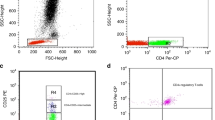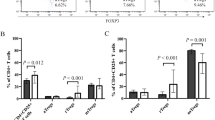Abstract
Primary immune thrombocytopenia (ITP) is an autoimmune heterogeneous disorder. Excessive activated CD4+ T effector cells (Teffs) and compromised regulatory T cells (Tregs) were reported in ITP patients, yet little is known about the mechanisms. Interleukin-10 (IL-10) is an important regulatory cytokine of Tregs in inflammatory condition. It has been recently highlighted that IL-10-producing Tregs contribute to the effective controls of several autoimmune diseases. Hence this study was aimed to examine the role of IL-10 produced by Tregs in newly diagnosed ITP patients. Newly diagnosed ITP patients and healthy volunteers were enrolled to assess the numbers of peripheral Th1, Th17 cells and Tregs. CD4+CD25−Teffs and CD4+CD25+Tregs were purified. CD4+CD25−Teffs, labeled with CFSE, were cultured alone or with Tregs for 5 days, and the supernatants were then collected for IL-10 concentration test. The role of IL-10 in Tregs’ inhibitory function was also determined. In ITP patients, Teffs were excessively activated, while the Tregs were numerically and functionally impaired. The percentages of IL-10+ Tregs in Tregs’ population were found elevated dramatically in ITP patients but decreased in the remitted patients. The IL-10 concentrations in the cultured supernatant were decreased in ITP patients but elevated in the remitted patients. Furthermore, the IL-10 secretion by Tregs was dramatically decreased in ITP patients. IL-10 treatment enhanced the suppression effect of Tregs toward Teffs, whereas anti-IL-10 treatment boosted the proliferation of Teffs and Th17 cells. Excessive activated Teffs and impaired Tregs play major roles in the exuberant CD4+ T cells immune responses of ITP. The inhibitory effect of Tregs toward Teffs is largely exerted by IL-10. Insufficient secretion of IL-10 compromises the inhibitory capability of Tregs against Teffs in newly diagnosed ITP patients.





Similar content being viewed by others
References
Rodeghiero F, Stasi R, Gernsheimer T, Michel M, Provan D, Arnold DM, et al. Standardization of terminology, definitions and outcome criteria in immune thrombocytopenic purpura of adults and children: report from an international working group. Blood. 2009;113(11):2386–93. doi:10.1182/blood-2008-07-162503.
Panitsas FP, Theodoropoulou M, Kouraklis A, Karakantza M, Theodorou GL, Zoumbos NC, et al. Adult chronic idiopathic thrombocytopenic purpura (ITP) is the manifestation of a type-1 polarized immune response. Blood. 2004;103(7):2645–7. doi:10.1182/blood-2003-07-2268.
Pene J, Chevalier S, Preisser L, Venereau E, Guilleux MH, Ghannam S, et al. Chronically inflamed human tissues are infiltrated by highly differentiated Th17 lymphocytes. J Immunol. 2008;180(11):7423–30.
Harrington LE, Hatton RD, Mangan PR, Turner H, Murphy TL, Murphy KM, et al. Interleukin 17-producing CD4+ effector T cells develop via a lineage distinct from the T helper type 1 and 2 lineages. Nat Immunol. 2005;6(11):1123–32.
Park H, Li Z, Yang XO, Chang SH, Nurieva R, Wang YH, et al. A distinct lineage of CD4 T cells regulates tissue inflammation by producing interleukin 17. Nat Immunol. 2005;6(11):1133–41.
Guo ZX, Chen ZP, Zheng CL, Jia HR, Ge J, Gu DS, et al. The role of Th17 cells in adult patients with chronic idiopathic thrombocytopenic purpura. Eur J Haematol. 2009;82(6):488–9.
Sollazzo D, Trabanelli S, Curti A, Vianelli N, Lemoli RM, Catani L. Circulating CD4+ CD161+ CD196+ Th17 cells are not increased in immune thrombocytopenia. Haematologica. 2011;96(4):632–4.
Ji L, Zhan Y, Hua F, Li F, Zou S, Wang W, et al. The ratio of Treg/Th17 cells correlates with the disease activity of primary immune thrombocytopenia. PLoS One. 2012;7(12):e50909. doi:10.1371/journal.pone.0050909.
Zhu X, Ma D, Zhang J, Peng J, Qu X, Ji C, et al. Elevated interleukin-21 correlated to Th17 and Th1 cells in patients with immune thrombocytopenia. J Clin Immunol. 2010;30(2):253–9.
Zhang J, Ma D, Zhu X, Qu X, Ji C, Hou M. Elevated profile of Th17, Th1 and Tc1 cells in patients with immune thrombocytopenic purpura. Haematologica. 2009;94(9):1326–9.
Rocha AM, Souza C, Rocha GA, de Melo FF, Clementino NC, Marino MC, et al. The levels of IL-17A and of the cytokines involved in Th17 cell commitment are increased in patients with chronic immune thrombocytopenia. Haematologica. 2011;96(10):1560–4. doi:10.3324/haematol.2011.046417.
Yu J, Heck S, Patel V, Levan J, Yu Y, Bussel JB, et al. Defective circulating CD25 regulatory T cells in patients with chronic immune thrombocytopenic purpura. Blood. 2008;112(4):1325–8. doi:10.1182/blood-2008-01-135335.
Liu B, Zhao H, Poon MC, Han Z, Gu D, Xu M, et al. Abnormality of CD4(+)CD25(+) regulatory T cells in idiopathic thrombocytopenic purpura. Eur J Haematol. 2007;78(2):139–43.
Shevach EM. Mechanisms of foxp3+ T regulatory cell-mediated suppression. Immunity. 2009;30(5):636–45.
Miyara M, Gorochov G, Ehrenstein M, Musset L, Sakaguchi S, Amoura Z. Human FoxP3+ regulatory T cells in systemic autoimmune diseases. Autoimmun Rev. 2011;10(12):744–55.
Li MO, Flavell RA. Contextual regulation of inflammation: a duet by transforming growth factor-beta and interleukin-10. Immunity. 2008;28(4):468–76.
Yamaguchi T, Wing JB, Sakaguchi S. Two modes of immune suppression by Foxp3+ regulatory T cells under inflammatory or non-inflammatory conditions. Semin Immunol. 2011;23(6):424–30. doi:10.1016/j.smim.2011.10.002.
Chaudhry A, Samstein RM, Treuting P, Liang Y, Pils MC, Heinrich JM, et al. Interleukin-10 signaling in regulatory T cells is required for suppression of Th17 cell-mediated inflammation. Immunity. 2011;34(4):566–78.
Huber S, Gagliani N, Esplugues E, O’Connor W Jr, Huber FJ, Chaudhry A, et al. Th17 cells express interleukin-10 receptor and are controlled by Foxp3(−) and Foxp3+ regulatory CD4+ T cells in an interleukin-10-dependent manner. Immunity. 2011;34(4):554–65.
de Kouchkovsky D, Esensten JH, Rosenthal WL, Morar MM, Bluestone JA, Jeker LT. MicroRNA-17-92 regulates IL-10 production by regulatory T cells and control of experimental autoimmune encephalomyelitis. J Immunol. 2013;191(4):1594–605.
Kornete M, Sgouroudis E, Piccirillo CA. ICOS-dependent homeostasis and function of Foxp3+ regulatory T cells in islets of nonobese diabetic mice. J Immunol. 2012;188(3):1064–74.
Moon SJ, Park JS, Heo YJ, Kang CM, Kim EK, Lim MA, et al. In vivo action of IL-27: reciprocal regulation of Th17 and Treg cells in collagen-induced arthritis. Exp Mol Med. 2013;45:e46.
Bao W, Bussel JB, Heck S, He W, Karpoff M, Boulad N, et al. Improved regulatory T-cell activity in patients with chronic immune thrombocytopenia treated with thrombopoietic agents. Blood. 2010;116(22):4639–45.
Stasi R, Cooper N, Del Poeta G, Stipa E, Laura Evangelista M, Abruzzese E, et al. Analysis of regulatory T-cell changes in patients with idiopathic thrombocytopenic purpura receiving B cell-depleting therapy with rituximab. Blood. 2008;112(4):1147–50. doi:10.1182/blood-2007-12-129262.
Fiorentino DF, Zlotnik A, Vieira P, Mosmann TR, Howard M, Moore KW, et al. IL-10 acts on the antigen-presenting cell to inhibit cytokine production by Th1 cells. J Immunol. 1991;146(10):3444–51.
Ding L, Shevach EM. IL-10 inhibits mitogen-induced T cell proliferation by selectively inhibiting macrophage costimulatory function. J Immunol. 1992;148(10):3133–9.
Fitzgerald DC, Zhang GX, El-Behi M, Fonseca-Kelly Z, Li H, Yu S, et al. Suppression of autoimmune inflammation of the central nervous system by interleukin 10 secreted by interleukin 27-stimulated T cells. Nat Immunol. 2007;8(12):1372–9.
McGeachy MJ, Bak-Jensen KS, Chen Y, Tato CM, Blumenschein W, McClanahan T, et al. TGF-beta and IL-6 drive the production of IL-17 and IL-10 by T cells and restrain T(H)-17 cell-mediated pathology. Nat Immunol. 2007;8(12):1390–7.
Provan D, Stasi R, Newland AC, Blanchette VS, Bolton-Maggs P, Bussel JB, et al. International consensus report on the investigation and management of primary immune thrombocytopenia. Blood. 2010;115(2):168–86.
Neunert C, Lim W, Crowther M, Cohen A, Solberg L Jr, Crowther MA. The american society of hematology 2011 evidence-based practice guideline for immune thrombocytopenia. Blood. 2011;117(16):4190–207.
Semple JW, Freedman J. Increased antiplatelet T helper lymphocyte reactivity in patients with autoimmune thrombocytopenia. Blood. 1991;78(10):2619–25.
Ogawara H, Handa H, Morita K, Hayakawa M, Kojima J, Amagai H, et al. High Th1/Th2 ratio in patients with chronic idiopathic thrombocytopenic purpura. Eur J Haematol. 2003;71(4):283–8.
Kuwana M, Ikeda Y. The role of autoreactive T-cells in the pathogenesis of idiopathic thrombocytopenic purpura. Int J Hematol. 2005;81(2):106–12.
Saraiva M, O’Garra A. The regulation of IL-10 production by immune cells. Nat Rev Immunol. 2010;10(3):170–81.
Kole A, He J, Rivollier A, Silveira DD, Kitamura K, Maloy KJ, et al. Type I IFNs regulate effector and regulatory T cell accumulation and anti-inflammatory cytokine production during T cell-mediated colitis. J Immunol. 2013;191(5):2771–9.
Stumhofer JS, Silver JS, Laurence A, Porrett PM, Harris TH, Turka LA, et al. Interleukins 27 and 6 induce STAT3-mediated T cell production of interleukin 10. Nat Immunol. 2007;8(12):1363–71.
Hall AO, Beiting DP, Tato C, John B, Oldenhove G, Lombana CG, et al. The cytokines interleukin 27 and interferon-gamma promote distinct Treg cell populations required to limit infection-induced pathology. Immunity. 2012;37(3):511–23.
Murai M, Turovskaya O, Kim G, Madan R, Karp CL, Cheroutre H, et al. Interleukin 10 acts on regulatory T cells to maintain expression of the transcription factor Foxp3 and suppressive function in mice with colitis. Nat Immunol. 2009;10(11):1178–84. doi:10.1038/ni.1791.
Chang JH, Xiao Y, Hu H, Jin J, Yu J, Zhou X, et al. Ubc13 maintains the suppressive function of regulatory T cells and prevents their conversion into effector-like T cells. Nat Immunol. 2012;13(5):481–90. doi:10.1038/ni.2267.
Naundorf S, Schroder M, Hoflich C, Suman N, Volk HD, Grutz G. IL-10 interferes directly with TCR-induced IFN-gamma but not IL-17 production in memory T cells. Eur J Immunol. 2009;39(4):1066–77.
Gu Y, Yang J, Ouyang X, Liu W, Li H, Yang J, et al. Interleukin 10 suppresses Th17 cytokines secreted by macrophages and T cells. Eur J Immunol. 2008;38(7):1807–13.
Huse M, Lillemeier BF, Kuhns MS, Chen DS, Davis MM. T cells use two directionally distinct pathways for cytokine secretion. Nat Immunol. 2006;7(3):247–55.
Hua F, Ji L, Zhan Y, Li F, Zou S, Wang X, et al. Pulsed high-dose dexamethasone improves interleukin 10 secretion by CD5+ B cells in patients with primary immune thrombocytopenia. J Clin Immunol. 2012;32(6):1233–42. doi:10.1007/s10875-012-9714-z.
Kamanaka M, Huber S, Zenewicz LA, Gagliani N, Rathinam C, O’Connor W Jr, et al. Memory/effector (CD45RB(lo)) CD4 T cells are controlled directly by IL-10 and cause IL-22-dependent intestinal pathology. J Exp Med. 2011;208(5):1027–40.
Acknowledgments
This work was supported by grants from National Natural Science Foundation of China (30972737, 81170473 and 81300381) and Shanghai Health Bureau Funding (20134y117 and 20124223). All authors obtain permission to acknowledge from all those mentioned in the Acknowledgements.
Conflict of interest
The authors declare that they have no competing interests.
Author information
Authors and Affiliations
Corresponding authors
Additional information
Feng Li and Lili Ji have contributed equally to this work as the first authorship.
Electronic supplementary material
Below is the link to the electronic supplementary material.
12026_2014_8620_MOESM1_ESM.tif
The purification of Tregs and Teffs. Representative dot plots of CD4+T cells, CD4+CD25+ Tregs, and CD4+CD25− Teffs. The purification of each cell type was above 90 % (TIFF 1201 kb)
12026_2014_8620_MOESM2_ESM.tif
Comparative percentage of IL-10+ Teffs was detected in the NC and ITP groups. NC: normal control; ITP: ITP group; p values were indicated in the figure (TIFF 269 kb)
12026_2014_8620_MOESM3_ESM.tif
Isotype control FCM figure for Fig. 1j. It is the isotype control figure for Foxp3 and IL-10 antigen in PBMCs stimulated with PMA, ionomycin and BFA (TIFF 353 kb)
12026_2014_8620_MOESM4_ESM.tif
Isotype control FCM figure for Fig. 2a and c. It is the isotype control figure for IFN-γ and il-17A antigen of CD4+T cells cultured for 5 days, stimulated with PMA, ionomycin and BFA (TIFF 385 kb)
12026_2014_8620_MOESM5_ESM.tif
Isotype control FCM figure for Fig. 3a. It is the isotype control figure for Foxp3 and IL-10 antigen in CD4+CD25+T cells cultured for 5 days, stimulated with PMA, ionomycin and BFA (TIFF 375 kb)
Rights and permissions
About this article
Cite this article
Li, F., Ji, L., Wang, W. et al. Insufficient secretion of IL-10 by Tregs compromised its control on over-activated CD4+ T effector cells in newly diagnosed adult immune thrombocytopenia patients. Immunol Res 61, 269–280 (2015). https://doi.org/10.1007/s12026-014-8620-2
Published:
Issue Date:
DOI: https://doi.org/10.1007/s12026-014-8620-2




